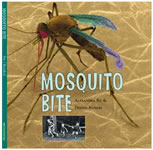Web 2.0
Where's the good stuff?
What's useful for young people?
What applies to school environments?
 Technology has played a role in teaching and learning for many years. For example, you might start by reading the book Mosquito Bite by Alexandra Siy and Dennis Kunkel. Students might then use a digital camera and software such as PowerPoint or Word to write their own story. In the last decade, the web has played an increasing role in technology-rich learning. Students might access online images of microscopic worlds and combine them with their own photographs. Some examples include:
Technology has played a role in teaching and learning for many years. For example, you might start by reading the book Mosquito Bite by Alexandra Siy and Dennis Kunkel. Students might then use a digital camera and software such as PowerPoint or Word to write their own story. In the last decade, the web has played an increasing role in technology-rich learning. Students might access online images of microscopic worlds and combine them with their own photographs. Some examples include:
- Dennis Kunkel Microscopy - Education
- Most Wanted Bugs
- Molecular Expressions
- Scanning Electronic Microscopy
The introduction of Web 2.0 technology allows students to reach beyond the school. For example, they might take their own microscopic photographs and submit them to the Small World Photography contest. Or, create a blog like Micro Images Blog that allows students to comment on the work of others. Smithsonian Encyclopedia of Life is a collaborative project by the US National Museum of Natural History to document the earth's diversity by scientists and citizens of Earth described by E.O. Wilson in The Creation. A related project is Consortium for the Barcode of Life. Check out the Barcode Blog.
Joyce Valenza from Springfield Township High School is a wonderful example of a School Library Media Specialist who is part of the 2.0 movement. The evolution of her Virtual Library resources reflects her philosophy. In the past we just explored her website, now our students interact with her and other media specialists on a class blog.
Examples of Web 2.0:
- Pearl Harbor Survivor Stories
- Pandora - music site that learns what you like
- Duck Diaries - blog
- Become involved in a content-specific example of Web 2.0. Use BugGuide.
- Want more ideas? Check out the Web 2.0 Award Winners.
 Brainstorm!
Brainstorm!
What features of Web 2.0 have potential in making information more accessible? Envision a "far out" application of Web 2.0 in information, teaching, or learning.
What are the features of Web 2.0 that have potential for teaching and learning? Discuss how a traditional activity could be expanded using Web 2.0 technology.

